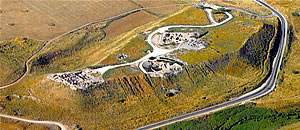Hazor
 |
HAZOR -
l. The city of Jabin (Jos.11.1 etc.), in Naphtali (Jos.19.36), S. of Kedesh (1 Mac.11.63,67 etc., called in To.1.2 Asher), overlooking Lake Semechonitis = el-Huleh (Jos. Ant. v. v. 1 [199]). It is identified with el-Qedah (Khirbet Waqqas) about 3 miles south-west of Thella on the lake. The archaeological history of the site has been determined by the James A. de Rothschild expedition, 1955-1958, directed by Y. Yadin (Hazor I [1958], II [1959], III, and IV in preparation; preliminary reports in BA and IEJ [1956-1959]). It is described in Jos.11.10 as 'the head of all those kingdoms.' Its pre-eminence dates from the 18th cent. BC, as attested by the Mari archives; it also figures as a major political and commercial centre in the Amarna age (14th cent.). By the time of Joshua its influence had begun to wane, though it still ranked at the head of the northern coalition. Its destruction by the Israelites toward the end of the 13th cent. has been confirmed by the excavations. Solomon fortified it (1 K.9.15). It was taken by Tiglath-pileser III. (2 K.15.29).
2. A town in the Negeb of Judah (Jos.15.23), unidentified.
3. A town also in the Negeb, identified with Kerioth-hezron (Jos.15.25); but the text is difficult (cf J. Simons, The Geographical and Topographical Texts of the Old Testament [1959], p. 143).
4. A place in Benjamin, N. of Jerusalem (Neh.11.33), probably Khirbet Hazzur, between Beit Haninah and Neby Samwil.
5. The kingdoms of Hazor, named with Kedar (Jer.49.28 etc.), an Arabian district, possibly on the border of the desert.
[Article: Dictionary of the Bible, J.Hastings, 2nd Ed., T&T.Clark, 1963. - W.E. - D.N.F.]